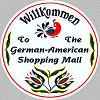|
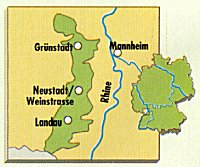
|
Pfalz
The German "Weinstrasse," or wine route, connects the two winegrowing regions of the Palatinate, or Pfalz, where the lushest vine yards in
Germany are to be found. Mittelhaardt is the northern area of this region with its renowned wine-growing towns such as Forst, Deidesheim, Wachenheim, Ungstein, Kallstadt, and Bad Dürkheim. The southern wine
route begins near Neustadt, along the fields around Landau. Birkweiler, Siebeldingen, Hainfeld, and Burrweiler are the area's most famous wine towns. With riesling in the Mittelhaardt and burgundies in the
south, some 23,700 hectares of vineyards can be found in this region. |
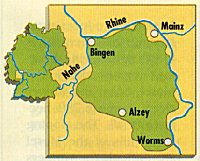
|
Rheinhessen
Germany's largest winegrowing region (some 26,500 hectares) used to be famous above all for its new cultivations, a fact which deprived the area of
a distinctive image. Moreover, many vintners sold a lot of wine by the barrel, up to 65% of which were filled outside the region, especially by large concerns in the Mosel Valley. This was done to feed both
supermarkets and the export demand for Liebfrauenmilch. But this region nestled between Bingen, Mainz, and Worms is gradually shedding its cheap image. There are now several vineyards south of Mainz which
produce excellent wines, and winegrowers in the Rhine-Hesse area are also beginning to make progress. |
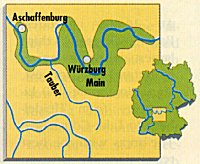
|
Franken
The Bavarian wineland of Franconia, or Franken, has expanded over the past few decades from little more than 2,000 hectares to its present 6,000. Wines
from this region are easily identified by the squat little bottles they come in, called "Bocksbeutel." The most important wine areas can be found in Würzburg, Randersacker, and east of Würzburg,
along the Main (Volkach, Nordheim, Escherndorf), and in Steigerwald (Castell, Iphofen). Spätburgunder is gaining a name in the western part of this region. Müller-Thurgau (2,700 hectares) and silvaner (1, 2
50 hectares) are the most prominent varieties. The wines from this region tend to be earthy. |
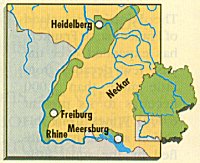
|
Baden and Württemberg
At 16,300 hectares, Baden is Germany's third largest wine-growing region, and the longest, stretching some 400 kilometers (250 miles) from
Heidelberg to Lake Constance. The areas with the best reputations are Ortenau (riesling, spätburgunder), Kaiserstuhl (burgunder), and Markgräflerland (gutedel). The most important variety is Müller-Thurgau,
but the amount of land dedicated to producing this grape is being reduced. No other region has more spätburgunder, and the specialty of the area is a dry grauburgunder. Württemberg is a red wine region
(which accounts for a good 55% of the wine-growing land) but the leading wine is riesling. |
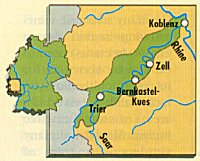
|
Mosel-Saar-Ruwer
Nowhere produces more riesling than Germany's fourth largest wine-growing region along the Mosel, Saar, and Ruwer rivers, some 6,750 hectares in
all. The sloping wine hills of the Moselare difficult for vintners to manage and they don't yield much. As a result, an increasing area is being left uncultivated. Moreover, the Mosel is a region of
extremes: You can find both fine, noble rieslings, some of which can be very expensive, as well as plenty of cheaper wines, produced mostly along the banks of the Mosel itself. The most interesting wines are
grown along the Saar, the Ruwer, and the mid-Mosel, as well as in Leiwen Trittenheim and Winningen. |
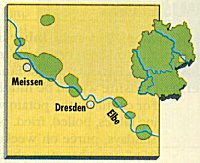
|
The new Federal States
German reunification revealed that, behind the Wall, there were the remains of what had been 10,000 hectares of winegrowing lands along
the Elbe, Saale, and Unstrut. Today, the overall area of vineyards is small (450 hectares along the Saale-Unstrut and 310 hectares in Saxony), and the vintners often have to fight against the frost which can
damage their Müller-Thurgau, riesling, and weissburgunder vines. There were originally just four major producers: two nationally owned, in Naumburg and Radebeul near Dresden, and two co-operatives, in
Freyburg and Meissen. They still exist, but the best wines now come from private vintners, whose numbers are growing. |
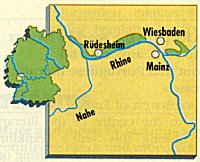
|
Rheingau
The small, fine Rhine Valley, or Rheingau, used to be synonymous with internationally renowned Rheinwein. Riesling dominates the region, accounting for
2,660 of the 3,270 hectares of land on which wine grapes are grown. Since 1983, the Vereinigung Rheingauer Charta-Weingüter - the local vinters' association - has had some success in latching onto the
Rheinwein tradition with a special, dry riesling grape. The Rhine Valley is responsible for first recognizing the value of late harvests, as well as the kabinett and auslese denominations. The most important
vineyards are at Rüdesheim, Johannisberg, Erbach, Oestrich-Winkel, Medrich, and Assmannshausen. |
|
